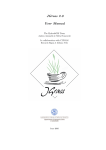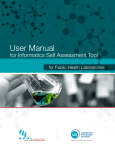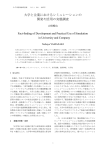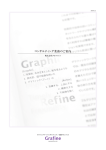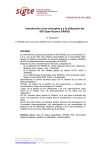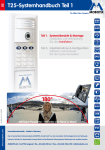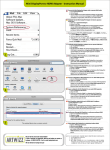Download GIS フリーソフト GRASS を体験しよう
Transcript
(社)日本写真測量学会関西支部主催 GIS 講習会 「GIS フリーソフト GRASS を体験しよう」 2006年7月31日 会場:近畿測量専門学校 講師:(有)画像計測研究所 小野 徹 体験用 CD-R GRASS-KNOPPIX 日本語対応版 配布 日本測量協会「測量 CPD」単位認定 Powored by GRASS 6.0.2 Geographic Resources Analysis Support System Quantum GIS 0.7.4 KNOPPIX 5.0.1 日本語版 資料目次 1. 講演会の内容 …………………………………………… 2 2. 配布 CD-R “GRASS-KINOPPIXjp” について ………… 3 3. GRASS-KNOPPIX の使い方 …………………………… 4 4. GRASS6 に関する情報 ………………………………… 12 5. GRASS コマンド一覧 …………………………………… 15 6. Spearfish データセット解説 ……………………………….29 -1- 日本写真測量学会関西支部 講習会 「GIS フリーソフト GRASS を体験しよう」 概 要 GRASS は、フリーのソフトウェアでありながら、多数の強力な機能を持ち合わせていることもあっ て世界中で使われている GIS ソフトです。しかし、UNIX 系の OS で育ったソフトであるため、使い 始めるまでのハードルが高く、入り口で断念した方も多いでしょう。 日本写真測量学会関西支部では、GIS について初歩的な知識を持ち合わせている方々を対象として、 OS などの予備知識がなくても簡単に GRASS を体験できる本講習会を企画いたしました。体験版の CD-R などを基に、実際に PC を使った講習内容としており、講習会を受ければすぐに GRASS を使い 始めることができるよう配慮しています。また、GRASS のさまざまな機能を活かした適用例の実演を 通して、その魅力もあわせて紹介していきます。 ■ 日 時 平成 18 年 7 月 31 日(月) 13:00~18:00(12:45 受付開始) ■ 場 所 近畿測量専門学校 3階 演習室 (住所: 大阪市東住吉区矢田 1-5-9) ■ 主 催:社団法人日本写真測量学会関西支部 ■ 講 師:小野 徹(画像計測研究所) ■ プログラム 13:00~13:05 開会挨拶 13:05~14:00 GRASS の紹介 14:00~14:30 GRASS を用いた応用例の実演 14:30~14:40 休憩 14:40~15:40 実習(1) 基本操作とデモプログラムの実行 15:40~15:50 休憩 15:50~16:50 実習(2) ラスターデータを用いた実習 16:50~17:00 休憩 17:00~17:55 実習(3) ベクターデータを用いた実習 17:55~18:00 閉会挨拶 ■ 連絡先 (社)日本写真測量学会関西支部 〒572-8508 大阪府寝屋川市池田中町 17-8 摂南大学工学部都市環境システム工学科 熊谷研究室内 TEL&FAX: 072-839-3301 E-mail: [email protected] -2- 配布 CD-R ”GRASS-KNOPPIXjp”について この CD-R は産業技術総合研究所によって開発された KNOPPIX5.0 日本語版をベースに GRASS 6.0.2 と関連ソフトウェアやデータをインストールしたものです。日本写真測量学会関西 支部の GRASS 講習会(2006/7/31)のために作られたものですが、自由にコピーして利用したり 配布することができます。 この CD-R からブートすることで、インストールやセットアップすることなく GRASS を体験すること ができます。 また、全くの初心者でも GRASS を手軽に体験することができるよう、デモスクリプトが用意されて います。もちろん、通常の手順で GRASS を利用することもできます。 体験用とはいえ、フルスペックの GRASS がインストールされており、ほとんど全ての機能が利用 できます。ただし、ユーザが作ったデータは、外部メモリなどに保存しない限り、リブートやシャッ トダウンをした時点で消滅しますので御注意ください。 動作環境 Windows が動作する PC であれば動作するはずです。必要なスペックなどは KNOPPIX のドキュ メントをご覧ください。この CD-R に入っているサンプルデータのみを用いる限りにおいては、多く のメモリは消費しないはずです。とはいえ、RAMDISK を利用するので、メモリは少なくとも 256MB はあった方がよいでしょう。512MB 以上を推奨します。 GRASS そのものはあまり重いソフトでは ないので、CPU は遅くても問題ありません。 CD-ROM ドライブは高速な方がよいでしょう。 モニターの解像度は 1024x768 以上であることを想定しています。それより低くても動作しないわ けではありませんが、使いにくいのは間違いありません。 PC によっては正しく動作しないことがあります。これは KNOPPIX の問題です。また、CD-ROM ド ライブ(DVD なども含む)が搭載されていない PC や搭載されていても、 CD-ROM ドライブからブ ートできない PC では利用できません。 免責事項 この CD-R を利用したことで、何らかの不都合が生じたとしても作者は全く責任を負いません。ま た、問い合わせやクレームについても対処しかねます。このことを十分理解したうえで御利用く ださい。 (有)画像計測研究所 小野 徹 2006 年 7 月 31 日 -3- GRASS-KNOPPIXjpの使い方 1. GRASS-KNOPPIXjpの起動方法 KNOPPIX5.0.1 日本語版をベースにしているので、KNOPPIX の起動方法に準じます。 (1) (2) (3) DVD-RAM/DVD-R/DVD-ROM/CD-ROM ドライブに配布 CD-R を入れて、PC を再 起動してください。 もし、再起動したときに、KNOPPIX が起動しない場合は、PCを CD-ROM から起動で きるよう設定してください。通常、BIOS の設定(boot setup などのメニューがあるはず です)を変更して、CD-ROM を一番目にアクセスするようにします。具体的な方法は 機種ごとに異なるので、お持ちの PC の取扱説明書をご覧下さい。 Boot メニューが現れたら Enter キーを押して起動します。 2. GRASS を知る まず、GRASS や GIS がどんなものなのか知らなければ話になりません。 GRASS や GIS につ いて知るためのとてもよくできた教材として、大阪市立大学の升本先生とラガワン先生の 「 GRASS を用いた地理情報システム入門」を参照するとよいでしょう。ただし、GRASS5 での利 用を前提としているので、本 CD-R に入っている GRASS6とは GUI と一部のコマンドが異なりま すので、注意が必要です。 英語のドキュメントを読むのが苦痛でないなら、GRASS の オフィシャルサイト をぜひ覗いて みましょう。沢山の優れたチュートリアルも紹介されています。 この CD-R の中には、大阪市立大学の実習でも使われている GRASS SEED のデータや他の多 くのチュートリアルで使われている spearfish というデータも入っています。そのため、ダウンロー ドやインストールの手間なく、すぐに試してみることができます。 GRASS のサンプルデータは/home/knoppix/data に入っています。 3. GRASS Demo GRASS でどんなことができるのかを手っ取り早く知るには、GRASS Demo を実行するのがよ いでしょう。デスクトップ上に"grass-demo"と書かれたアイコンがあるので、それをクリックしてみ ましょう。以下のような画面が現れるはずです。 -4- 番号を入れて Enter キーを押せばデモが始まります。マウスを使ったインタラクティブな操作が 必要となるデモもありますが、ほとんどは自動的に実行されます。また、どのようなコマンドがど のような働きをするのかが、おおよそわかるようになっています。 デモの番号を入れずに Enter キーを押せば GRASS Demo が終了します。 4. GRASS の実行 GRASS はコンソール(仮想端末)から実行します。コンソールは画面最下部のパネル(下図)の モニターのアイコンをクリックすると立ち上がります。 コンソール上で grass と入力すると、GRASS が実行されます。 GRASS を実行すると、以下のようなメッセージが出ま すが気にせず、Enter キーを押します。なお、このメッセージは最初に起動したときだけ現れま す。 -5- 次に、以下のような画面が出てきます。 ここでは、まずサンプルデータが置いてあるフォルダ(Database)を指定する必要があります。サ ンプルデータは/home/knoppix/data にありますから、 "/home/knoppix"に"/data"を追加する だけです。そして Enter を押すと、下図のようにいくつかの Location が現れます。ここでは下図の -6- ように spearfish を選んでください。 また、Mapset は user のような新たなものを作って、それを選択してください。 [Enter GRASS]をクリックすると、以下のような GUI(GIS Manager)が現れます。 この GUI を使ってほとんどの操作を行うことができます。 -7- もし誤って GIS Manager を終了させてしまったら、コンソール上で d.m & を実行してください。 5. QGIS Quantum GIS 略して QGIS を GRASS の GUI として使うこともできます。 QGIS から GRASS のコマンドを利用するには、GRASS のパスが通っている必要があるので、GRASS をたちあげた コンソールから qgis & として QGIS を実行するとよいでしょう。 QGIS では、GRASS のプラグインを読み込むことで GRASS のデータを表示したり GRASS のコ マンドを実行したりすることができるようになります。 QGIS ではメニューも最初から日本語化されており操作もしやすいですが、QGIS から実行でき る GRASS のコマンドは現時点では限られています。 -8- 6. データの保存方法 データを保存する方法はいくつかありますが、ここでは USB メモリなど外部メ ディアを用いる方法について説明します。PC に内蔵している HDD にもアクセス 可能ですが、Windows 2000 や XP の場合 NTFS というファイルシステムになって いることが多く、KNOPPIX からは簡単には書き込めないようになっています。 そのため USB メモリなど NTFS ではない外部メディアに保存することにしましょう。 KNOPPIX のデスクトップを見ると、Floppy や Hard Disk というアイコンがあり ます(右図)。USB メモリを差し込むと、ここに新たな Hard Disk が加わります。 これが [sda1] というデバイス名であるとします(PC のハードウェア構成によっ てはデバイス名が異なることがあります)。これらのデバイスは最初は書き込み 不可となっているので、書き込み可となるよう変更が必要です。 このデバイスのアイコン上で右クリックすると、下図のようなメニューが現れます。 ここで、[Change read/write mode] というメニューをクリックして、書き込み可にします。 次に、アイコンを左クリックすると下図のような、Konqueror というウィンドウが起動します。 -9- これは Windows で言うところの Explorer のようなもので、ドラッグアンドドロップでファイルをコピ ーしたり移動したり、削除するといったことができます。 データをコピーしたら、USB メモリを抜く前に「マウント解除」を行う必要があります。これは、デ バイスのアイコン上で右クリックしたときに現れるメニューから行います。 さらなる詳細は KNOPPIX に関するドキュメントを参照してください。 7. GRASS の終らせかた GRASS を終了するときには必ずコンソール上で exit として終了してください。 Windows と同じ感覚で Konsole を閉じて終わらせるとモニターが残った ままになったり、ロックファイルが残ったりして不具合が生ずる可能性があります。 8. GRASS-KNOPPIXjp の終らせかた GRASS-KNOPPIXjp を終了させると、保存していないデータは消えてしまいますので気をつけて ください。 GRASS-KNOPPIX を終了するには、パネルの左端の K メニューを押して 「ログアウト」を選ぶと終了画面が現れるので「コンピュータの停止」か「コンピュータの再起動」を選びま す。 - 10 - GRASS6 に関する情報 1. GRASS について GRASS は Geographical Resources Analysis Support System の略称であり、あえて訳すなら 地理資源解析支援システムとなります。GRASS は米国陸軍 CERL(Construction Engineering Research Laboratory)を中心として開発された地理情報システム(GIS)のソフトウェアであり、そ の後世界中のさまざまな組織によりメンテナンスが継承されています。2006 年 7 月現在では、世 界中の有志より成る GRASS Development Team によって開発が進められ、配布などのホ ストをイタリアの ITC(Istituto Trentino di Cultura:敢えて訳せばトレント文化協会)が 請け負っています。 GRASS は以下の特徴を持ちます。 • パブリックドメインであり、自由に配布され無料または安価に入手できる • オープンソースであり、ライブラリも整備されているため独自プログラム作成が容易である • 非常に多くの強力なツールを持ち、ドキュメントも豊富である • ラスターデータ、ベクターデータともに充実した機能を持つが、特にラスターデータの処理 が得意である • サンプルのデータベースが無料で提供されており、他形式からのインポートも容易である • 世界中に多くのユーザを持ち、独自のコミュニティを形成している • 様々な OS 上で動作する 2.GRASS6について 2006 年7月現在の GRASS の最新公式バージョンは 6.0.2 であり、開発中の 6.1 のβバージョ ンも入手可能である。GRASS6 では主に以下のような新機能の追加や改良が行われた。 • • • • • • ベクターデータの扱いの強化 : 3D データの利用, DBMS での管理など GIS Manager と呼ばれる新しい GUI : レイヤーを使った表示など 新バージョンの NVIZ(3D 表示ツール) : 3D ベクター、voxel データへの対応など 国際化正式対応 : 日本語などマルチバイト文字の表示、TrueType フォント対応 GDAL/OGC ライブラリに対応 : 各種データの変換が容易になった EPGS コードに対応 : Location の設定が容易になった さらに、QGIS が GRASS6 をサポートし、これを用いることで GRASS 独自の表示関連の扱いにく さからも解放されることになりました。 これにより、これまで GRASS の弱点と言われていたベクターデータの扱いや使いにくさ、国際 化への非対応といった問題はほぼ全て解決されたことになります。 - 11 - 3. GRASS に関する情報源と入手方法 GRASSのホームページはイタリアITCの http://grass.itc.it です。このページは様々なところ でミラー(全く同じ内容をコピーして公開)されており、日本においては大阪市立大学の http://wgrass.media.osaka-cu.ac.jp/grassh/index.php にあります。これらがオフィシャルサイトと いうことになります。GRASS における最新情報や各種ドキュメント、GRASS のダウンロードなど はここから辿ることができます。 GRASS の日本語版については、FOSS4G のサイト(http://www.grass-japan.org/FOSS4G/)で フォント付きの国際化版が入手可能なほか、株式会社オークニーにより日本語版が販売されて います。 4. ドキュメント GRASS には多数のドキュメントが存在しますが、初めて利用しようという方にはチュートリアル 形式のものを利用することをお薦めします。日本語で書かれたものとしては、大阪市立大学の 升本先生とラガワン先生によって書かれた「GRASS を用いた地理情報システム入門」がよくでき ており、独学で高度な演習が可能です。ただし、GRASS6 については対応していないので、本文 書などと併用することをお薦めします。 英語で書かれた GRASS6 のドキュメントとして代表的なものには以下のものがあります。 • • • リファレンスマニュアル(いわゆる map page) (HTML 形式) ← homepage より プログラマーズマニュアル (HTML 形式, PDF 形式) ← homepage より Die GDF Hannover のチュートリアル http://www.gdf-hannover.de/media.php?id=0&lg=en • Open Source Geospatial '05 Conference のチュートリアル http://mpa.itc.it/markus/osg05/ GRASS5 以前のものですが良くできたチュートリアルとして、 • Tutrial GRASS5 http://www.ing.unitn.it/~grass/docs/tutorial/english/index_en.htm • GRASS Seeds Beginner's Tutorial http://www.geog.le.ac.uk/assist/grass/seeds/ などがあります。なお、GRASS Seeds については、上記の大阪市立大学のサイトの実習中で 扱っており、日本語訳されたものがあるので、そちらを参照するとよいでしょう。 5. 使用できるハードウェア ほとんど全てのパソコンやワークステーションで利用可能です。 OSとしては、Linux/Mac OSX/MS Windows(Cygwin)についてはオフィシャルサイトにてバイナ リ形式で提供されています。ソースからコンパイルすれば、上記以外の OS でも UNIX 系の OS - 12 - であれば利用可能です。オフィシャルサイト以外のところでバイナリファイルが提供されているこ ともあるので、検索してみるとよいでしょう。PC だけでなく、iPAQや Zaurus といった PDAでも利 用可能です。 また、OS レベルでサポートされている周辺機器であれば、GRASS からも利用可能です。ただ し、Windows 用のドライバーしか提供されていない場合には、Linux や Mac OSX 上から利用する ことはできないことがあるので注意が必要です。一部のデジタイザーなど GRASS がドライバーを 用意しているものもありますが、バイナリファイルでドライバーが提供されているとは限りません。 GRASS のデータをプリンタやプロッタで印刷したい場合は、画像ファイルや Postscript ファイル、 テキストファイルなどに落として、印刷すればよいでしょう。 6. インストールの方法 GRASS を利用する方法としては以下の3つの方法があります。 (1) バイナリファイルをインストールする (2) ソースファイルをコンパイルしてインストールする (3) Live CD-ROM を利用する (PC にインストールせずに利用する) 利用するプラットフォームによって、インストール方法が異なります。それぞれの詳細について はオフィシャルページからリンクされているので参照してください。ここでは、Windows ユーザが PC 上で利用する場合について説明します。 GRASS を触ったことも見たこともないというユーザは、まず最初に Live CD-ROM を入手して 使ってみることをお薦めします。Live CD-ROM を提供しているサイトにはオフィシャルサイトから リンクが張ってあるので、そこから CD-ROM を購入するか ISO ファイルをダウンロードして、自分 で CD-R や CD-RW に焼きます。 インストールする手間がないので、とても簡単に GRASS を体験することができます。 Windows マシンに GRASS をインストールする方法には、 (a) Cygwin を入れて Cygwin 用の GRASS をインストールする (b) Cygwin と coLinux を入れて、Linux 用の GRASS をインストールする (c) VMWare やVirtual PC,Bochsなどの仮想 PC 上に Linux を入れて、Linux 用の GRASS をインストールする (d) winGRASS(QGIS with GRASS)をインストールする。 という4つの方法があります。このうち最も簡単なのが(d)であるが、QGIS がβバージョンなの で、本格的な利用についてはいまのところお薦めできませんが、試してみるだけならインストー ルも簡単なのでよいでしょう。将来的にはメインの環境となる可能性もあるので、今後の動向 が注目されるところです。 次に簡単なのが(a)です。Cygwin とは、Windows で動く UNIX エミュレート環境です。動作がい まひとつ安定していないこと、Cygwin 用のバイナリしか動かせないので Cygwin 用のバイナリが 用意されていないツールは自分でコンパイルしない限り利用できないこと、動作がやや遅いこ - 13 - と、などいくつか問題もありますが、(b),(c)と比べるとずっと利用が簡単です。Cygwin のインスト ール自体はとても簡単で、Cygwin のサイトにある setup プログラムを実行するだけです。そして、 あとは説明書の通りに Cygwin 用の GRASS をインストールするだけです。しかし、Cygwin のバ ージョンや Cygwin に入れたライブラリのバージョンなどによっては、GRASS が正常に動かない こともあるようです。 Cygwin よりも安定した環境で GRASS に関連する全てのソフトを高速に動かしたいのなら、 (b),(c)のような仮想PC上で Linux を動かす方法もあります。この方法は Linux をインストールし たうえで、さらに GRASS をインストールする必要があるなど、インストールの手間と利用の際に 必要な知識が多く、Windows ユーザにはあまりお薦めできません。 6. 日本語への対応 GRASS6 は国際化されており、日本語でのデータ入力や表示にも対応しています。日本語の データを表示するには日本語 TrueType フォントを指定する必要があります。メニューやメッセー ジも日本語用の翻訳ファイル(.po)があれば日本語化が可能です。翻訳ファイルの最新版はオフ ィシャルサイト GRASS5 に対応した日本語翻訳ファイルはありますが、残念ながら現時点では GRASS6 に対応したものはないようです。とはいえ、QGIS という GUI のメニューは日本語化され ているため、QGIS を使うならば特に使用上の不都合はあまりないでしょう。 - 14 - GRASS コマンド一覧 種別 d.* display commands (表示) db.* database commands (データベース) g.* general commands (一般) g3.* general3D commands (一般3D関係) i.* imagery commands (衛星画像など画像セットの扱い) p.* paint commands (画像出力関係) pg.* postGRASS commands (データベース postgress) ps.* postscript commands (Postscript 出力) r.* raster commands (ラスターデータの処理) r3.* raster3D commands (ラスターデータの3D関連の処理) v.* vector commands (ベクターデータの処理) Nviz visualization command (3D 表示) コマンドリスト d.ask Prompts the user to select a GRASS data base file from among files displayed in a menu on the graphics monitor. d.barscale Displays a barscale on GRASS monitor. d.colorlist Output a list of all available display colors with a configurable separator (default is comma). d.colors Allows the user to interactively change the color table d.colortable To display the color table associated with a raster map layer. d.erase Erase the contents of the active display frame with user defined color d.extend Set window region so that all currently displayed raster, vector and sites maps can be shown in a monitor. d.font.freetype Selects the font in which text will be displayed on the user's graphics monitor. d.font Selects the font in which text will be displayed on the user's graphics monitor. d.frame Manages display frames on the user's graphics monitor. d.geodesic Displays a geodesic line, tracing the shortest distance between two geographic points along a great circle, in a longitude/latitude data set. - 15 - d.graph Program for generating and displaying simple graphics to the graphics display monitor. d.grid Overlays a user-specified grid in the active display frame on the graphics monitor. d.his Displays the result obtained by combining hue, intensity, and saturation (his) values from user-specified input raster map layers. d.histogram Displays a histogram in the form of a pie or bar chart for a user-specified raster file. d.info Display information about the active display monitor d.legend Displays a legend for a raster map layer in the active frame on the graphics monitor. d.linegraph Generates and displays simple line graphs in the active graphics monitor display frame. d.mapgraph Generates and displays simple graphics on map layers drawn in the active graphics monitor display frame. d.measure Measures the lengths and areas of features drawn by the user in the active display frame on the graphics monitor. d.m d.mon To establish and control use of a graphics display monitor. d.monsize Selects/starts specified monitor at specified size d.nviz Create fly-through script to run in NVIZ d.out.png Saves active display monitor to PNG file in home directory d.paint.labels Displays text labels formatted for use with GRASS paint (p.labels, p.map) output to the active frame on the graphics monitor. d.path Find shortest path for selected starting and ending node d.profile Interactive profile plotting utility with optional output. d.rast.arrow Draws arrows representing cell aspect direction for a raster map containing aspect data. d.rast.edit d.rast.edit d.rast Displays and overlays raster map layers in the active display frame on the graphics monitor. d.rast.leg Displays a raster map and its legend on a graphics window d.rast.num Overlays cell category values on a raster map layer displayed to the graphics monitor. - 16 - d.redraw d.redraw d.resize Resizes active display monitor d.rgb Displays three user-specified raster map layers as red, green, and blue overlays in the active graphics frame. d.rhumbline Displays the rhumbline joining two user-specified points, in the active frame on the user's graphics monitor. d.save Create a list of commands for recreating screen graphics. d.slide.show Slide show of GRASS raster/vector maps d.split Divides active display into 2 frames & displays maps/executes commands in each frame. d.text.freetype Draws text in the graphics monitor's active display frame using TrueType fonts. d.text Draws text in the active display frame on the graphics monitor using the current font. d.title Outputs a TITLE for a raster map layer in a form suitable for display by d.text. d.vect.chart Displays charts of GRASS vector data in the active frame on the graphics monitor. d.vect Displays GRASS vector data in the active frame on the graphics monitor. d.what.rast Allows the user to interactively query the category contents of multiple raster map layers at user specified locations within the current geographic region. d.what.vect Allows the user to interactively query a vector map layer at user-selected locations within the current geographic region. d.where Identifies the geographic coordinates associated with point locations in the active frame on the graphics monitor. d.zoom Allows the user to change the current geographic region settings interactively, with a mouse. db.* commands: db.columns list all columns for a given table. db.connect Connect to the database through DBMI. db.copy Copy a table. Either 'from_table' (optionaly with 'where') can be used or 'select' option, but not 'from_table' and 'select' at the same time. db.describe Describe a table (in detail). db.drivers List all database drivers. db.droptable - 17 - db.execute Execute any SQL statement. db.login Set user/password for driver/database. db.select Select data from database. db.tables List all tables for a given database. db.test Test database driver, database must exist and set by db.connect. g.* commands: g.access g.ask Prompts the user for the names of GRASS data base files. g.copy Copies available data files in the user's current mapset search path and location to the appropriate element directories under the user's current mapset. g.filename Prints GRASS data base file names. g.findfile Searches for GRASS data base files and sets variables for the shell. g.gisenv Outputs and modifies the user's current GRASS variable settings. g.list Lists available GRASS data base files of the user-specified data type to standard output. g.manual display the HTML man pages of GRASS g.mapset Change current mapset g.mapsets Modifies the user's current mapset search path, affecting the user's access to data existing under the other GRASS mapsets in the current location. g.mlist Apply regular expressions and wildcards to g.list g.mremove Apply regular expressions and wildcards to g.remove g.parser g.parser g.proj Prints and manipulates GRASS projection information files. g.region Program to manage the boundary definitions for the geographic region. g.remove Removes data base element files from the user's current mapset. g.rename To rename data base element files in the user's current mapset. g.setproj g.setproj g.tempfile Creates a temporary file and prints the file name. g.version Displays version and copyright information. i.* commands: i.cca Canonical components analysis (cca) program for image processing. - 18 - i.class i.class i.cluster An imagery function that generates spectral signatures for land cover types in an image using a clustering algorithm. The resulting signature file is used as input for i.maxlik, to generate an unsupervised image classification. i.fft Fast Fourier Transform (FFT) for image processing. i.fusion.brovey Brovey transform to merge multispectral and high-res panchromatic channels i.gensig Generates statistics for i.maxlik from raster map layer. i.gensigset Generate statistics for i.smap from raster map layer. i.group Creates and edits groups and subgroups of imagery files. i.his.rgb Hue-intensity-saturation (his) to red-green-blue (rgb) raster map color transformation function. i.ifft Inverse Fast Fourier Transform (ifft) for image processing. i.image.mosaic Mosaics up to 4 images and extends colormap; creates map *.mosaic i.maxlik An imagery function that classifies the cell spectral reflectances in imagery data based on the spectral signature information generated by either i.cluster, i.class, or i.gensig. i.oif Calculates Optimum-Index-Factor table for LANDSAT TM bands 1-5, & 7 i.ortho.photo i.ortho.photo i.pca Principal components analysis (pca) program for image processing. i.points i.rectify Rectifies an image by computing a coordinate transformation for each pixel in the image based on the control points i.rgb.his Red-green-blue (rgb) to hue-intensity-saturation (his) raster map color transformation function. i.smap Performs contextual image classification using sequential maximum a posteriori (SMAP) estimation. i.spectral displays spectral response at user specified locations in images i.target Targets an imagery group to a GRASS location and mapset. i.tasscap Tasseled Cap (Kauth Thomas) transformation for LANDSAT-TM data i.vpoints i.vpoints i.zc Zero-crossing "edge detection" raster function for image processing. p.* commands: p.out.vrml module to output GRASS data in the format of Virtual Reality Modeling Language - 19 - (VRML) pg.* commands: pg.postgisdb pg.postgisdb photo.* commands: photo.2image photo.2image photo.2target photo.2target photo.camera photo.init photo.init photo.rectify photo.rectify ps.* commands: ps.map Hardcopy PostScript map output utility. r.* commands: r.average Finds the average of values in a cover map within areas assigned the same category value in a user-specified base map. r.basins.fill Generates a raster map layer showing watershed subbasins. r.bilinear Bilinear interpolation utility for raster map layers. r.blend Blends color components of 2 raster maps by a given % first map' r.buffer Creates a raster map layer showing buffer zones surrounding cells that contain non-NULL category values. r.cats Prints category values and labels associated with user-specified raster map layers. r.circle Creates a raster map containing concentric rings around a given point. r.clump Recategorizes data in a raster map layer by grouping cells that form physically discrete areas into unique categories. r.coin Tabulates the mutual occurrence (coincidence) of categories for two raster map layers. r.colors Creates/Modifies the color table associated with a raster map layer. r.composite Combines red, green and blue map layers into a single composite map layer. - 20 - r.compress Compresses and decompresses raster files. r.contour Produces a GRASS binary vector map of specified contours from GRASS raster map layer. r.cost Outputs a raster map layer showing the cumulative cost of moving between different geographic locations on an input raster map layer whose cell category values represent cost. r.covar Outputs a covariance/correlation matrix for user-specified raster map layer(s). r.cross Creates a cross product of the category values from multiple raster map layers. r.describe Prints terse list of category values found in a raster map layer. r.digit r.digit r.distance Locates the closest points between objects in two raster maps. r.drain Traces a flow through an elevation model on a raster map layer. r.fill.dir Filters and generates a depressionless elevation map and a flow direction map from a given elevation layer r.fillnulls Fills no-data areas in raster maps using v.surf.rst splines interpolation r.flow Construction of slope curves (flowlines), flowpath lengths, and flowline densities (upslope areas) from a raster digital elevation model(DEM). r.grow Generates a raster map layerwith contiguous areas grown by one cell. r.his Generates red, green and blue raster map layers combining hue, intensity, and saturation (his) values from user-specified input raster map layers. r.in.arc Convert an ESRI ARC/INFO ascii raster file (GRID) into a (binary) raster map layer. r.in.ascii Convert an ASCII raster text file into a (binary) raster map layer. r.in.bin Import a binary raster file into a GRASS raster map layer. r.info Outputs basic information about a user-specified raster map layer. r.in.gdal Import GDAL supported raster file into a binary raster map layer. r.in.gridatb Imports GRIDATB.FOR map file (TOPMODEL) into GRASS raster map r.in.mat Import a binary MAT-File(v4) to a GRASS raster. r.in.poly Create raster maps from ascii polygon/line data files in the current directory. r.in.srtm Import SRTM HGT files into GRASS r.kappa Calculate error matrix and kappa parameter for accuracy assessment of classification result. r.le.patch - 21 - r.le.pixel r.le.setup r.le.setup r.le.trace r.los Line-of-sight raster analysis program. r.mapcalc r.mapcalc r.mapcalculator r.mapcalculator - Calculates new raster map from r.mapcalc expression r.median Finds the median of values in a cover map within areas assigned the same category value in a user-specified base map. r.mfilter Raster file matrix filter. r.mode Finds the mode of values in a cover map within areas assigned the same category value in a user-specified base map. r.neighbors Makes each cell category value a function of the category values assigned to the cells around it, and stores new cell values in an output raster map layer. r.null The function of r.null is to explicitly create the NULL-value bitmap file. r.out.arc Converts a raster map layer into an ESRI ARCGRID file. r.out.ascii Converts a raster map layer into an ASCII text file. r.out.bin Exports a GRASS raster to a binary array. r.out.gdal Exports GRASS raster data into various formats (requires GDAL) r.out.gridatb Exports GRASS raster map to GRIDATB.FOR map file (TOPMODEL) r.out.mat Exports a GRASS raster to a binary MAT-File. r.out.mpeg Raster File Series to MPEG Conversion Program. r.out.png Export GRASS raster as non-georeferenced PNG image format. r.out.pov Converts a raster map layer into a height-field file for POVRAY. r.out.ppm3 Converts 3 GRASS raster layers (R,G,B) to a PPM image file at the pixel resolution of the CURRENTLY DEFINED REGION. r.out.ppm Converts a GRASS raster file to a PPM image file at the pixel resolution of the CURRENTLY DEFINED REGION. r.out.tiff Exports a GRASS raster file to a 8/24bit TIFF image file at the pixel resolution of the currently defined region. r.param.scale Extracts terrain parameters from a DEM. Uses a multi-scalar approach by taking fitting quadratic parameters to any size window (via least squares) r.patch Creates a composite raster map layer by using known category values from one (or more) map layer(s) to fill in areas of "no data" in another map layer. r.plane Creates raster plane map given dip (inclination), aspect (azimuth), and one - 22 - point r.profile Outputs the raster map layer values lying on user-defined line(s). r.proj Re-project a raster map from one location to the current location. r.quant This routine produces the quantization file for a floating-point map. r.random Creates a raster map layer and vector point map containing randomly located sites. r.random.surface Generates random surface(s) with spatial dependence. r.reclass.area Reclasses a raster map greater or less than user specified area size (in hectares) r.reclass Creates a new map layer whose category values are based upon the user's reclassification of categories in an existing raster map layer. r.recode Recode raster maps. r.region Sets the boundary definitions for a raster map. r.regression.line Calculates linear regression from two raster maps: y = a + b*x r.report Reports statistics for raster map layers. r.resample GRASS raster map layer data resampling capability. r.resamp.rst Reinterpolates and computes topographic analysis from input raster file to a new raster file (possibly with different resolution) using regularized spline with tension and smoothing. r.rescale.eq Rescales histogram equalized the range of categoryvalues in a raster map layer. r.rescale Rescales the range of category values in a raster map layer. r.series Makes each output cell value a function of the values assigned to the corresponding cells in the input raster map layers. r.shaded.relief Creates shaded relief map from an elevation map (DEM). r.slope.aspect Generates raster map layers of slope, aspect, curvatures and partial derivatives from a raster map layer of true elevation values. Aspect is calculated counterclockwise from east. r.spread Simulates elliptically anisotropic spread on a graphics window and generates a raster map of the cumulative time of spread, given raster maps containing the rates of spread (ROS), the ROS directions and the spread origins. It optionally produces raster maps to contain backlink UTM coordinates for tracing spread paths. r.spreadpath Recursively traces the least cost path backwards to cells from which the cumulative cost was determined. - 23 - r.statistics Category or object oriented statistics. r.stats Generates area statistics for raster map layers. r.sum Sums up the raster cell values. r.sun Computes direct (beam), diffuse and reflected solar irradiation raster maps for given day, latitude, surface and atmospheric conditions. Solar parameters (e.g. sunrise, sunset times, declination, extraterrestrial irradiance, daylight length) are saved in the map history file. Alternatively, a local time can be specified to compute solar incidence angle and/or irradiance raster maps. The shadowing effect of the topography is optionally incorporated. r.sunmask Calculates cast shadow areas from sun position and DEM. Either A: exact sun position is specified, or B: date/time to calculate the sun position by r.sunmask itself. r.surf.area Surface area estimation for rasters. r.surf.contour Surface generation program from rasterized contours. r.surf.fractal GRASS module to create a fractal surface of a given fractal dimension. Uses spectral synthesis method. Can create intermediate layers showing the build up of different spectral coefficients (see Saupe, pp.106-107 for an example of this). Use this module to generate naturally looking synthetical elevation models (DEM). r.surf.gauss GRASS module to produce a raster map layer of gaussian deviates whose mean and standard deviation can be expressed by the user. It uses a gaussian random number generator. r.surf.idw2 Surface generation program. r.surf.idw Surface interpolation utility for raster map layers. r.surf.random Produces a raster map layer of uniform random deviates whose range can be expressed by the user. r.terraflow Flow computation for massive grids (Float version). r.texture Generate images with textural features from a raster map r.thin Thins non-zero cells that denote linear features in a raster map layer. r.timestamp Print/add/remove a timestamp for a raster map. r.topidx Creates topographic index, ln(a/tan(beta)), map from elevation map. r.topmodel Simulates TOPMODEL which is a physically based hydrologic model. r.to.vect Converts a raster map into a vector map layer. r.transect Outputs raster map layer values lying along user defined transect line(s). r.univar Calculates univariate statistics from the non-null cells of a raster map. - 24 - r.univar.sh calculates univariate statistics from a GRASS raster map r.water.outlet Watershed basin creation program. r.watershed Watershed basin analysis program. r.what Queries raster map layers on their category values and category labels. r3.* commands: r3.in.ascii Convert a 3D ASCII raster text file into a (binary) 3D raster map layer r3.info Outputs basic information about a user-specified 3D raster map layer. r3.in.v5d import of 3-dimensional Vis5D files (i.e. the v5d file with 1 variable and 1 time step) r3.mapcalc r3.mapcalc r3.mask Establishes or removes the current working 3D raster mask. r3.mkdspf r3.null Explicitly create the 3D NULL-value bitmap file. r3.out.ascii Converts a 3D raster map layer into an ASCII text file r3.out.v5d Export of GRASS 3D raster file to 3-dimensional Vis5D file. r3.timestamp print/add/remove a timestamp for a 3D raster map v.* commands: v.buffer Create a buffer around features of given type (areas must contain centroid). v.build.all v.build.all v.build Creates topology for GRASS vector data. v.build.polylines Build polylines from lines. v.category Attach, delete or report vector categories to map geometry. v.clean Toolset to clean vector topology. v.convert.all v.convert Imports older versions of GRASS vectors. v.db.connect prints/sets DB connection for a vector map v.db.select Print vector attributes v.delaunay Create a Delaunay triangulation from an input vector of points or centroids. v.digit v.distance Find the nearest element in vector 'to' for elements in vector 'from'. Various information about this relation may be uploaded to the attribute table of input - 25 - vector 'from' or printed to stdout. v.external Create a new vector as a read-only link to OGR layer. Available drivers: v.extract Selects vector objects from an existing vector map and creates a new map containing only the selected objects. If 'list', 'file' and 'where' options are not specified, all features of given type and layer are extracted, categories are not changed in that case. v.hull Uses a GRASS vector points map to produce a convex hull vector map v.in.ascii Convert GRASS ascii file or points file to binary vector. v.in.db Create new vector (points) from database table containing coordinates. v.in.e00 Import of E00 file into a vector map. v.info Outputs basic information about a user-specified vector map layer. v.in.garmin Upload Waypoints, Routes, and Tracks from a Garmin GPS receiver into a vector map. v.in.ogr Convert OGR vectors to GRASS. Available drivers: v.in.region Create a new vector from current region. v.in.sites.all v.in.sites Converts a GRASS site_lists file into a vector file. v.kcv Randomly partition points into test/train sets. v.kernel Generates a raster density map from vector points data using a moving 2D isotropic Gaussian kernel or optionally generates a vector density map on vector network with a 1D kernel v.label Create paint labels for GRASS vector file and attached attributes. v.mkgrid Creates a (binary) GRASS vector map of a user-defined grid. v.neighbors Makes each cell value a function of the attribute values assigned to the vector points or centroids around it, and stores new cell values in an output raster map layer. v.net.alloc Allocate subnets for nearest centres (direction from centre). Centre node must be opened (costs >= 0). Costs of centre node are used in calculation v.net Network maintenance. v.net.iso Split net to bands between cost isolines (direction from centre). Centre node must be opened (costs >= 0). Costs of centre node are used in calculation v.net.path Find shortest path on vector network. Reads start/end pointsfrom standard input in 2 possible formats: v.net.salesman Create a cycle connecting given nodes (Traveling salesman problem). Note that - 26 - TSP is NP-hard, heuristic algorithm is used by this module and created cycle may be sub optimal. v.net.steiner Create Steiner tree for the network and given terminals. Note that 'Minimum Steiner Tree' problem is NP-hard and heuristic algorithm is used in this module so the the result may be sub optimal. v.normal tests for normality for points. v.out.ascii Convert a GRASS binary vector map to a GRASS ASCII vector map v.out.dxf Exports GRASS vector files to DXF file format. v.out.ogr Convert to OGR format. v.out.pov Convert to POV-Ray format, GRASS x,y,z -> POV-Ray x,z,y v.overlay Overlay 2 vector maps. v.patch Creates a new binary vector map layer by combining other binary vector map layers. v.perturb Random location perturbations of GRASS sites. v.proj Allows projection conversion of vector files. v.qcount indices for quadrat counts of sites lists v.random Randomly generate a GRASS vector points map. v.reclass Changes vector category values for an existing vector map according to results of SQL queries or a value in attribute table column. v.sample Sample a raster file at site locations. v.segment Create points/segments from input lines, and positions read from stdin in format: v.select Select features from ainput by features from binput. v.surf.idw Surface interpolation from sites data by Inverse Distance Squared Weighting. v.surf.rst Interpolation and topographic analysis from given point or contour data in vector format to GRASS floating point raster format using regularized spline with tension. v.to.db Load values from vector to database. In uploaded/printed category values '-1' is used for 'no category' and 'null'/'-' if category cannot be found or multiple categories were found. v.to.points Create points along input lines. v.to.rast Converts a binary GRASS vector map layer into a GRASS raster map layer. v.transform Transforms an vector map layer from one coordinate system into another coordinate system. - 27 - v.type Change the type of geometry elements. v.univar Calculates univariate statistics for attribute. Variance and standard deviation is calculated only for points. v.vol.rst Interpolates point data to a G3D grid volume using regularized spline with tension (RST) algorithm v.voronoi Create a Voronoi triangulation from an input vector of points or centroids. v.what.rast Upload raster values at positions of vector points to the table. - 28 - Spearfish データセット解説 配布 CD-R には、GRASS のサンプルデータとして spearfish と imagery, leics を用意していま す。このうち、spearfish と imagery は、米国サウスダコダ州に位置する spearfish という地域のデ ータで、前者はラスター形式の主題図とベクターマップ、後者は衛星画像データです。 ラスターデータの一覧 - 29 - ベクターデータの一覧 t. で始まるデータは TIGER データですが、t.9961.で始まるのがオリジナルのもので、その後に続 く 100 や 200 というのはブロック番号です。その後に all や bks、あるいは何もないものがあります - 30 - が、何もないのはブロックの境界だけを示すエリアデータです。all はそのブロック内の全ての TIGER データ、bks はブロック内部の境界線です。t.country や t.hydro などのデータは spearfish における TIGER データから様々な主題のデータを取り出したものです。 Imagery データ Imagery データは spearfish と同じ場所ですが座標系が異なり、x-y 座標系となっています。 - 31 -
































